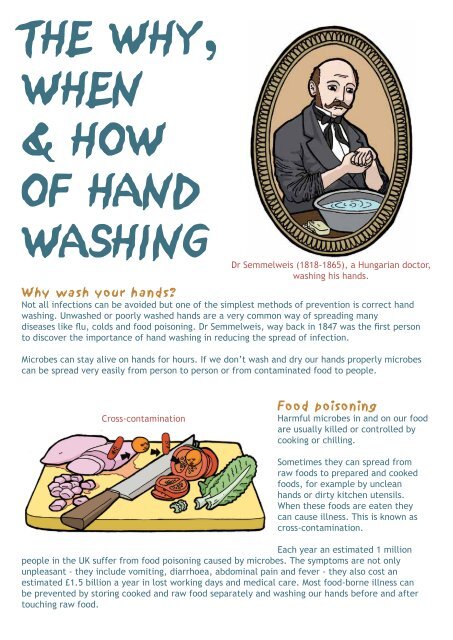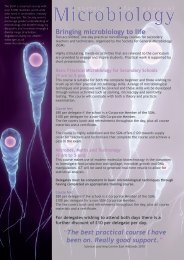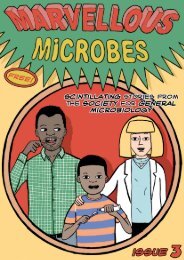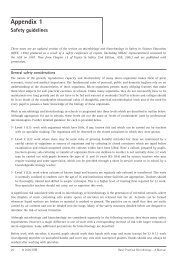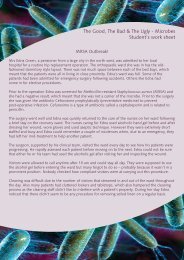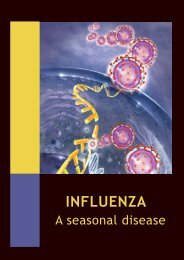The why, when and how of hand washing - Microbiology Online
The why, when and how of hand washing - Microbiology Online
The why, when and how of hand washing - Microbiology Online
Create successful ePaper yourself
Turn your PDF publications into a flip-book with our unique Google optimized e-Paper software.
THE WHY,<br />
WHEN<br />
& HOW<br />
OF HAND<br />
WASHING<br />
Dr<br />
Semmelweis (1818-1865), a Hungarian doctor,<br />
<strong>washing</strong> his h<strong>and</strong>s.<br />
Why wash your h<strong>and</strong>s?<br />
Not all infections can be avoided but one <strong>of</strong> the simplest methods <strong>of</strong> prevention is correct h<strong>and</strong><br />
<strong>washing</strong>. Unwashed or poorly washed h<strong>and</strong>s are a very common way <strong>of</strong> spreading many<br />
diseases like flu, colds <strong>and</strong> food poisoning. Dr Semmelweis, way back in 1847 was the first person<br />
to discover the importance <strong>of</strong> h<strong>and</strong> <strong>washing</strong> in reducing the spread <strong>of</strong> infection.<br />
Microbes can stay alive on h<strong>and</strong>s for hours. If we don’t wash <strong>and</strong> dry our h<strong>and</strong>s properly microbes<br />
can be spread very easily from person to person or from contaminated food to people.<br />
Cross-contamination<br />
Food poisoning<br />
Harmful microbes in <strong>and</strong> on our food<br />
are usually killed or controlled by<br />
cooking or chilling.<br />
Sometimes they can spread from<br />
raw foods to prepared <strong>and</strong> cooked<br />
foods, for example by unclean<br />
h<strong>and</strong>s or dirty kitchen utensils.<br />
When these foods are eaten they<br />
can cause illness. This is known as<br />
cross-contamination.<br />
Each year an estimated 1 million<br />
people in the UK suffer from food poisoning caused by microbes. <strong>The</strong> symptoms are not only<br />
unpleasant - they include vomiting, diarrhoea, abdominal pain <strong>and</strong> fever - they also cost an<br />
estimated £1.5 billion a year in lost working days <strong>and</strong> medical care. Most food-borne illness can<br />
be prevented by storing cooked <strong>and</strong> raw food separately <strong>and</strong> <strong>washing</strong> our h<strong>and</strong>s before <strong>and</strong> after<br />
touching raw food.
Cross-contamination, the transfer <strong>of</strong> microbes from raw foods to<br />
Cold virus particles being inhaled through the<br />
prepared <strong>and</strong> cooked foods, takes place by:<br />
nose <strong>and</strong> transported to the back <strong>of</strong> the throat.<br />
- raw food touching or splashing on cooked food<br />
- raw food touching equipment or surfaces that are then used for cooked food<br />
- people touching raw food with their h<strong>and</strong>s <strong>and</strong> then h<strong>and</strong>ling cooked food<br />
Types <strong>of</strong><br />
bacteria<br />
Time taken<br />
to develop<br />
Examples <strong>of</strong><br />
some risky<br />
foods<br />
Main<br />
symptoms<br />
Campylobacter<br />
1–3 days<br />
Red meat, poultry<br />
<strong>and</strong> raw milk.<br />
Abdominal cramps,<br />
fever <strong>and</strong><br />
diarrhoea.<br />
Campylobacter<br />
Salmonella<br />
1-3 days<br />
Meat, poultry,<br />
salads, eggs <strong>and</strong> raw<br />
egg products.<br />
Abdominal cramps,<br />
fever, diarrhoea<br />
<strong>and</strong> sickness.<br />
Strains <strong>of</strong><br />
Escherichia<br />
coli<br />
Listeria<br />
varies, usually<br />
1-4 days<br />
varies<br />
Meat, raw milk <strong>and</strong><br />
salads.<br />
S<strong>of</strong>t cheeses, paté<br />
<strong>and</strong> chilled readyto-eat<br />
products.<br />
Abdominal cramps<br />
<strong>and</strong> bloody<br />
diarrhoea.<br />
Some strains can<br />
cause serious<br />
complications.<br />
Flu-like symptoms.<br />
Septicaemia <strong>and</strong><br />
meningitis may<br />
develop.<br />
Bacillus cereus<br />
8-16 hours<br />
Cooked rice<br />
<strong>and</strong> cooked meats.<br />
Abdominal cramps,<br />
fever, diarrhoea<br />
<strong>and</strong> sickness.<br />
Spreading infection<br />
Influenza<br />
At home<br />
Infections such as colds <strong>and</strong> flu are spread by<br />
touch, just as much as coughs <strong>and</strong> sneezes.<br />
Microbes that cause these infections can be<br />
passed from person to person by h<strong>and</strong> contact or<br />
by touching contaminated surfaces such as door<br />
h<strong>and</strong>les or light switches. Infections can be<br />
avoided by correct h<strong>and</strong> <strong>washing</strong>, particularly<br />
after sneezing <strong>and</strong> blowing the nose.
Microbes on a door h<strong>and</strong>le.<br />
Microbes that cause infections can be passed<br />
from person to person by h<strong>and</strong> contact.<br />
In healthcare settings<br />
Disease-causing microbes can thrive in hospital <strong>and</strong> other healthcare environments because they<br />
can be easily passed between individuals.<br />
Common infections in healthcare settings include:<br />
- Meticillin-resistant Staphylococcus aureus (MRSA)<br />
- Clostridium difficile (C. diff)<br />
- Norovirus<br />
Norovirus<br />
Good h<strong>and</strong> hygiene is the most effective technique for reducing<br />
the spread <strong>of</strong> infection. Doctors, nurses <strong>and</strong> visitors must wash<br />
their h<strong>and</strong>s thoroughly <strong>and</strong> frequently <strong>and</strong> are encouraged to<br />
use alcohol-based gels in between h<strong>and</strong> <strong>washing</strong>.<br />
When should you wash your h<strong>and</strong>s?<br />
Before<br />
Preparing food<br />
Eating food<br />
Caring for the sick<br />
Looking after babies<br />
Looking after the elderly<br />
Putting in contact lenses<br />
After<br />
H<strong>and</strong>ling raw foods, especially meat<br />
Going to the toilet<br />
Touching rubbish or waste bins<br />
Changing nappies<br />
Caring for the sick<br />
Coughing or sneezing<br />
Touching pets <strong>and</strong> other animals<br />
Gardening
Campylobacter<br />
Fascinating facts<br />
An American study s<strong>how</strong>ed that only 85% <strong>of</strong> people actually do wash their h<strong>and</strong>s after going<br />
to the toilet, even though 95% said that they did!<br />
<strong>The</strong> number <strong>of</strong> microbes on fingertips can double after using the toilet.<br />
A staggering 1,000 times as many microbes are spread from damp h<strong>and</strong>s than dry h<strong>and</strong>s.<br />
A study in America s<strong>how</strong>ed that during daily activities, adults infected with the cold virus<br />
transferred it on average to 35% <strong>of</strong> the surfaces they touched.<br />
<strong>The</strong> most frequently contaminated objects are door h<strong>and</strong>les, pens, light switches, remote<br />
controls <strong>and</strong> taps.<br />
Cases <strong>of</strong> food poisoning tend to increase in the summer months as microbes thrive in warmer<br />
conditions <strong>and</strong> people can be less careful about food safety.<br />
It is impossible to tell from its appearance whether food is contaminated with Salmonella. It<br />
will look, smell <strong>and</strong> taste normal.<br />
<strong>The</strong> Society for General <strong>Microbiology</strong> (SGM) is a pr<strong>of</strong>essional body for scientists who work in all areas <strong>of</strong><br />
microbiology. An important function <strong>of</strong> the Society is the promotion <strong>of</strong> the public underst<strong>and</strong>ing <strong>of</strong><br />
microbiology. SGM produces <strong>and</strong> distributes a wide range <strong>of</strong> resources to support microbiology teaching in<br />
schools <strong>and</strong> colleges across all key stages <strong>and</strong> post -16. It also runs training courses in practical<br />
microbiology for teachers <strong>and</strong> technicians <strong>and</strong> occasional workshops. <strong>The</strong> Society also <strong>of</strong>fers an<br />
information service to teachers <strong>and</strong> participates in schools competitions <strong>and</strong> other activities.<br />
Written by Laura Udakis<br />
Designed <strong>and</strong> Edited by Dariel Burdass<br />
Marlborough House, Basingstoke Road, Spencers<br />
Wood, Reading RG7 1AG<br />
Tel. 0118 988 1802; Email education@sgm.ac.uk<br />
Illustrations by James BW Lewis<br />
www.jwestonlewis.co.uk<br />
Email jbwlewis@hotmail.co.uk<br />
© Society for General <strong>Microbiology</strong> 2011


